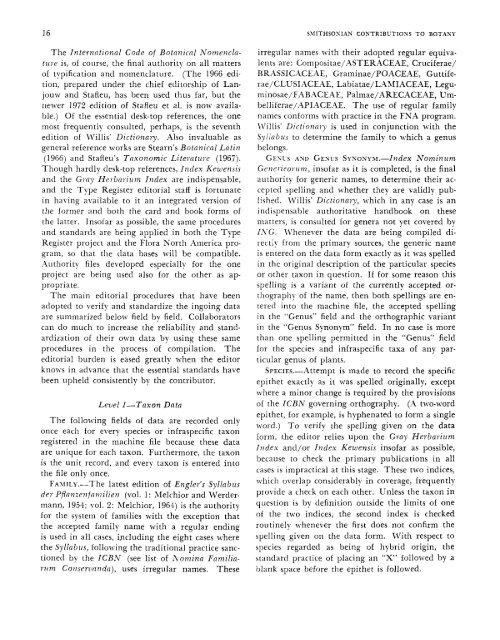An Introduction to the Botanical Type Specimen Register
An Introduction to the Botanical Type Specimen Register
An Introduction to the Botanical Type Specimen Register
You also want an ePaper? Increase the reach of your titles
YUMPU automatically turns print PDFs into web optimized ePapers that Google loves.
16 SXITHSOSIAN CONTRIBUTIONS TO BOTANY<br />
The Internotional Code of <strong>Botanical</strong> Nomencla-<br />
tu)e is, of course, <strong>the</strong> final authority on all matters<br />
of typification and nomenclature. (The 1966 edi-<br />
tion, prepared under <strong>the</strong> chief edi<strong>to</strong>rship of Lan-<br />
jouw and Stafleu, has been used thus far, but <strong>the</strong><br />
rietver 1972 edition of Stafleu et al. is now availa-<br />
ble.) Of <strong>the</strong> essential desk-<strong>to</strong>p references, <strong>the</strong> one<br />
most frequently consulted, perhaps, is <strong>the</strong> seventh<br />
edition of JVillis’ Dictionary. Also invaluable as<br />
general reference works are Stearn’s <strong>Botanical</strong> Latin<br />
(1966) and Stafleu’s Taxonomic Literature (1967).<br />
Though hardly desk-<strong>to</strong>p references, Index Kewensis<br />
and <strong>the</strong> G?ay He) bai ium Index are indispensable,<br />
and <strong>the</strong> <strong>Type</strong> <strong>Register</strong> edi<strong>to</strong>rial staff is fortunate<br />
in haking available <strong>to</strong> it an integrated version of<br />
<strong>the</strong> lormer and both <strong>the</strong> card and book forms of<br />
<strong>the</strong> latter. Insofar as possible, <strong>the</strong> same procedures<br />
and standards are being applied in both <strong>the</strong> <strong>Type</strong><br />
<strong>Register</strong> project ant1 <strong>the</strong> Flora North America pro-<br />
gram, so that <strong>the</strong> data bases will be compatible.<br />
.luthority files developed especially for <strong>the</strong> one<br />
project are being used also for <strong>the</strong> o<strong>the</strong>r as ap-<br />
propriate.<br />
The main edi<strong>to</strong>rial procedures that have been<br />
adopted <strong>to</strong> verify and standardize <strong>the</strong> ingoing data<br />
are summarized below field by field. Collabora<strong>to</strong>rs<br />
can do much <strong>to</strong> increase <strong>the</strong> reliability and stand-<br />
ardization of <strong>the</strong>ir own data by using <strong>the</strong>se same<br />
procedures in <strong>the</strong> process of compilation. The<br />
edi<strong>to</strong>rial burden is eased greatly when <strong>the</strong> edi<strong>to</strong>r<br />
knows in advance that <strong>the</strong> essential standards have<br />
been upheld consistently by <strong>the</strong> contribu<strong>to</strong>r,<br />
Level 1-Taxon Data<br />
The following fields of data are recorded only<br />
once each for every species or infraspecific taxon<br />
registered in <strong>the</strong> machine file because <strong>the</strong>se data<br />
are unique for each taxon. Fur<strong>the</strong>rmore, <strong>the</strong> taxon<br />
is <strong>the</strong> unit record, and every taxon is entered in<strong>to</strong><br />
<strong>the</strong> file only once.<br />
FA%fItu.-The latest edition of Engler’s Syllabus<br />
der Pflanzenfonizlien (vol. 1 : Melchior and Werder-<br />
mann, 1954; vol. 2: Melchior, 1964) is <strong>the</strong> authority<br />
for <strong>the</strong> system of families with <strong>the</strong> exception that<br />
<strong>the</strong> accepted family name with a regular ending<br />
is used in all cases, including <strong>the</strong> eight cases where<br />
<strong>the</strong> Syllabws, following <strong>the</strong> traditional practice sanc-<br />
tioned by <strong>the</strong> ICBA‘ (see list of h’omina Familia-<br />
rum Coriservandn), uses irregular names. These<br />
irregular names with <strong>the</strong>ir adopted regular equivalents<br />
are: Compositae/ASTERACEAE, Cruciferae/<br />
BRASSICACEAE, Graminae/POACEAE, Guttiferae/CLUSIACEXE,<br />
Labiatae/LAMIACEAE, Leguminosae/FABACEAE,<br />
Palmae/ARECACEAE, Umbelliferae/APIACEAE.<br />
The use of regular family<br />
names conforms with practice in <strong>the</strong> FNA program.<br />
IVillis’ Dictionary is used in conjunction with <strong>the</strong><br />
Syi;obus <strong>to</strong> determine <strong>the</strong> family <strong>to</strong> which a genus<br />
belongs.<br />
GEXS AND GENUS SYsoNuhr.-Index Nominum<br />
Gcne,’icorum, insofar as it is completed, is <strong>the</strong> final<br />
authority for generic names, <strong>to</strong> determine <strong>the</strong>ir accepted<br />
spelling and whe<strong>the</strong>r <strong>the</strong>y are validly published.<br />
IVillis’ Dictionary, which in any case is an<br />
indispensable authoritative handbook on <strong>the</strong>se<br />
matters, is consulted for genera not yet covered by<br />
I*YG. Il’henever <strong>the</strong> data are being compiled directiy<br />
from <strong>the</strong> primary sources, <strong>the</strong> generic name<br />
is entered on <strong>the</strong> data form exactly as it was spelled<br />
in <strong>the</strong> original description of <strong>the</strong> particular species<br />
or o<strong>the</strong>r taxon in queution. If for some reason this<br />
spelling is a variant of <strong>the</strong> currently accepted orthography<br />
of <strong>the</strong> name, <strong>the</strong>n both spellings are entered<br />
in<strong>to</strong> <strong>the</strong> machine file, <strong>the</strong> accepted spelling<br />
in <strong>the</strong> “Genus” field and <strong>the</strong> orthographic variant<br />
in <strong>the</strong> “Genus Synonym” field. In no case is more<br />
than one spelling permitted in <strong>the</strong> “Genus” field<br />
for <strong>the</strong> species and infraspecific taxa of any particular<br />
genus of plants.<br />
SPECIES.-Attempt is made <strong>to</strong> record <strong>the</strong> specific<br />
epi<strong>the</strong>t exactly as it was spelled originally, except<br />
where a minor change is required by <strong>the</strong> provisions<br />
of <strong>the</strong> ICBhT governing orthography. (A two-word<br />
epi<strong>the</strong>t, for example, is hyphenated <strong>to</strong> form a single<br />
word.) To verify <strong>the</strong> spelling given on <strong>the</strong> data<br />
form, <strong>the</strong> edi<strong>to</strong>r relies upon <strong>the</strong> Gray Heybarium<br />
Index and/or Index Kewensis insofar as possible,<br />
because <strong>to</strong> check <strong>the</strong> primary publications in all<br />
cases is impractical at this stage. These two indices,<br />
which overlap considerably in coverage, frequently<br />
provide a check on each o<strong>the</strong>r. Unless <strong>the</strong> taxon in<br />
question is by definition outside <strong>the</strong> limits of one<br />
of <strong>the</strong> two indices, <strong>the</strong> second index is checked<br />
routinely whenever <strong>the</strong> first does not confirm <strong>the</strong><br />
spelling given on <strong>the</strong> data form. TVith respect <strong>to</strong><br />
species regarded as being of hybrid origin, <strong>the</strong><br />
standard practice of placing an “X” followed by a<br />
blank space before <strong>the</strong> epi<strong>the</strong>t is followed.

















